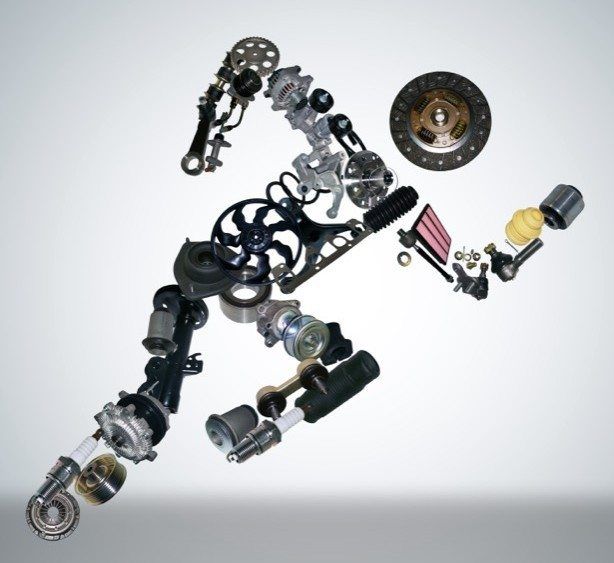Insufficient F-35 Parts: Pentagon Audit Uncovers Systemic Inventory Problems

Table of Contents
Systemic Issues in F-35 Parts Procurement and Management
The Pentagon audit exposed deep-seated flaws within the F-35 parts procurement and management system. These issues, stemming from a complex interplay of factors, have created a perfect storm of delays and cost overruns.
Complex Supply Chain Vulnerabilities
The F-35's supply chain is incredibly intricate, involving thousands of parts from hundreds of suppliers across the globe. This complexity has created several critical vulnerabilities highlighted by the audit:
- Reliance on Single-Source Suppliers: For many critical components, the F-35 program relies heavily on a single supplier. This lack of diversification creates a significant risk if that supplier experiences delays, disruptions, or quality control issues.
- Lack of Robust Inventory Tracking Systems: The audit revealed significant shortcomings in the systems used to track and manage F-35 parts inventory. Inaccurate data and a lack of real-time visibility into inventory levels contribute to significant delays in ordering replacement parts.
- Inadequate Forecasting: The current forecasting models appear to consistently underestimate the demand for spare parts, leading to persistent shortages. This underestimation is compounded by the increasing number of F-35s entering service.
These vulnerabilities translate into increased costs due to expedited shipping, reliance on workarounds, and significant delays in maintenance and repair. The result is a reduced operational capability for the F-35 fleet.
Inefficient Inventory Tracking and Management
The audit's findings strongly indicate inefficient inventory tracking and management practices are contributing to the F-35 parts shortage. This inefficiency leads to a cascade of negative consequences:
- Inaccurate Records: Inconsistencies and inaccuracies in inventory records make it difficult to accurately assess the availability of parts, leading to unnecessary delays in ordering replacements.
- Delays in Ordering Parts: The procurement process is often slow and cumbersome, resulting in significant delays between identifying a need for a part and receiving it.
- Lack of Real-Time Visibility: The absence of a real-time inventory management system prevents proactive identification of potential shortages and timely mitigation strategies.
Poor inventory management leads to increased aircraft downtime, higher maintenance costs, and a substantial reduction in the overall readiness of the F-35 fleet. This directly impacts mission success rates and compromises the military's operational effectiveness.
Impact on F-35 Operational Readiness and Mission Capability
The F-35 parts shortage has had a significant and measurable impact on the operational readiness and mission capability of the aircraft.
Reduced Flight Hours and Operational Availability
The direct consequence of the parts shortage is a noticeable reduction in flight hours and operational availability. The audit indirectly points to:
- Reduced Flight Hours: Many F-35s are grounded due to the unavailability of essential spare parts, leading to a significant reduction in total flight hours across the fleet.
- Grounded Aircraft: The number of F-35s grounded due to parts shortages is substantial, directly impacting the number of aircraft available for training and operational deployments.
- Mission Cancellations: The lack of available parts has led to the cancellation or postponement of numerous training exercises and operational missions.
This translates to a significant percentage reduction in flight hours and operational readiness, impacting the military's ability to respond effectively to potential threats.
Increased Maintenance Costs and Repair Times
The parts shortage has also resulted in significantly increased maintenance costs and repair times. This is primarily due to:
- Increased Costs of Expedited Shipping: To mitigate the impact of delays, the military often resorts to expedited shipping, which significantly increases the cost of obtaining parts.
- Reliance on Expensive Workarounds: In the absence of necessary parts, maintenance crews are sometimes forced to use expensive workarounds or improvisations, further increasing costs.
- Potential for Secondary Damage: Delays in repairing aircraft can lead to further damage or deterioration, increasing the overall cost of repair and maintenance.
These increased costs not only strain the F-35 program's budget but also raise serious questions about the long-term sustainability of the program.
Pentagon's Response and Potential Solutions for Addressing F-35 Parts Shortages
The Pentagon is responding to the audit's findings by implementing several initiatives aimed at resolving the F-35 parts shortage crisis.
Proposed Solutions and Remedial Actions
The Pentagon has outlined several key actions to address the identified weaknesses:
- Improved Inventory Management Systems: Investment in advanced inventory management systems with real-time visibility and predictive capabilities is a top priority.
- Diversification of Suppliers: Efforts are underway to diversify the supply base for critical components, reducing reliance on single-source suppliers.
- Enhanced Forecasting Models: Improved forecasting models, incorporating historical data and incorporating more sophisticated predictive analytics, are crucial to more accurately estimate future parts demand.
The effectiveness of these solutions will depend on their timely and thorough implementation, along with a commitment to continuous improvement in parts management processes.
Long-Term Implications and Future Planning
The F-35 parts shortage highlights the critical need for proactive planning and robust supply chain management. The long-term implications necessitate:
- Proactive Planning: A more proactive approach to anticipating and mitigating potential supply chain disruptions is essential.
- Robust Supply Chain Management: Investment in a robust and resilient supply chain is vital to ensure the long-term availability of essential parts.
- Investment in Advanced Inventory Technologies: Utilizing advanced technologies like AI and machine learning can significantly enhance inventory management and forecasting accuracy.
The future success of the F-35 program depends on a fundamental shift towards a more proactive and sophisticated approach to parts management.
Conclusion: Addressing the Critical F-35 Parts Shortage Crisis
The Pentagon audit has revealed a critical F-35 parts shortage stemming from systemic issues in procurement and management. This shortage significantly impacts operational readiness, increases maintenance costs, and threatens the long-term sustainability of the F-35 program. The key takeaways are the urgent need for improved inventory management systems, diversification of the supply chain, and enhanced forecasting models. The F-35 parts shortage demands immediate attention. Stay informed about the Pentagon's response and demand accountability for ensuring the readiness of our nation's most advanced fighter jet. The future of F-35 readiness depends on effective solutions to this critical F-35 parts supply challenge.

Featured Posts
-
 Controversy Erupts Trump Administration Demands Removal Of Transgender Swimmers Records From University Of Pennsylvania
May 01, 2025
Controversy Erupts Trump Administration Demands Removal Of Transgender Swimmers Records From University Of Pennsylvania
May 01, 2025 -
 Breda Stroomstoring 30 000 Klanten Treft Uitval
May 01, 2025
Breda Stroomstoring 30 000 Klanten Treft Uitval
May 01, 2025 -
 Frances Six Nations Triumph Mauvakas Mistakes And Lions Implications
May 01, 2025
Frances Six Nations Triumph Mauvakas Mistakes And Lions Implications
May 01, 2025 -
 Cooking Crab Stuffed Shrimp In Lobster Sauce A Detailed Recipe
May 01, 2025
Cooking Crab Stuffed Shrimp In Lobster Sauce A Detailed Recipe
May 01, 2025 -
 Ramos Leads France To Six Nations Victory Scotland Rout
May 01, 2025
Ramos Leads France To Six Nations Victory Scotland Rout
May 01, 2025
